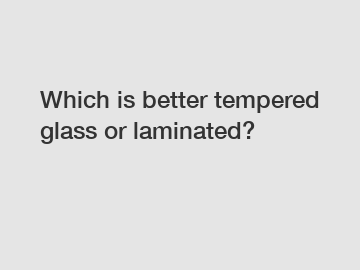Which is better tempered glass or laminated?
When it comes to selecting the right type of glass for your windows, doors, or other structures, two popular options are tempered glass and laminated glass. However, choosing between the two can be a challenging task, as each has its own set of advantages and disadvantages. In this article, we will compare tempered glass and laminated glass to help you make an informed decision.
**Tempered Glass**.
Tempered glass is created through a process of extreme heating and rapid cooling, which makes it four to five times stronger than standard glass. This type of glass is designed to shatter into small, dull pieces when broken, reducing the risk of injury. Tempered glass is commonly used in applications where safety is a concern, such as in car windows, shower doors, and glass walls.

One of the main advantages of tempered glass is its strength and durability. It is resistant to scratches, impacts, and extreme temperatures, making it a reliable choice for high-traffic areas. Additionally, tempered glass is easy to clean and maintain, making it a popular choice for residential and commercial spaces.
However, tempered glass does have its drawbacks. Once tempered glass is broken, it cannot be repaired and must be replaced entirely. Additionally, tempered glass can be more expensive than other types of glass, which may impact your budget.
**Laminated Glass**.
Laminated glass is made by sandwiching a layer of polyvinyl butyral (PVB) or resin between two or more layers of glass. This creates a strong, durable glass that holds together even when shattered. Laminated glass is commonly used in applications where safety and security are a top priority, such as in car windshields, skylights, and storefronts.
One of the main advantages of laminated glass is its ability to withstand impacts and breakage. The interlayer in laminated glass holds the glass together, preventing it from shattering into sharp pieces. Laminated glass also provides sound insulation and UV protection, making it a versatile choice for a variety of applications.
However, laminated glass does have its limitations. While it is durable, laminated glass can be more susceptible to scratches and may require more maintenance than tempered glass. Additionally, laminated glass may be more expensive than other types of glass, depending on the specific application.
**Conclusion**.
In conclusion, both tempered glass and laminated glass have their own unique set of advantages and disadvantages. When deciding between the two, it is essential to consider the specific needs of your project, including safety requirements, budget constraints, and maintenance considerations. If safety is a top priority and budget allows, laminated glass may be the best option. However, if durability and ease of maintenance are more critical, tempered glass may be the better choice.
Ultimately, the decision of whether to use tempered glass or laminated glass will depend on your individual preferences and requirements. Consulting with a glass professional can help you determine which type of glass is best suited for your project.
When choosing between tempered glass and laminated glass, consider the unique benefits and drawbacks of each to make an informed decision that suits your needs. If you have any questions or need assistance selecting the right type of glass for your project, feel free to contact us for expert advice and guidance.
For more heat resistant tempered glass, tempered frosted glass panels, is toughened glass the same as tempered glassinformation, please contact us. We will provide professional answers.
192
0
0

Comments
All Comments (0)